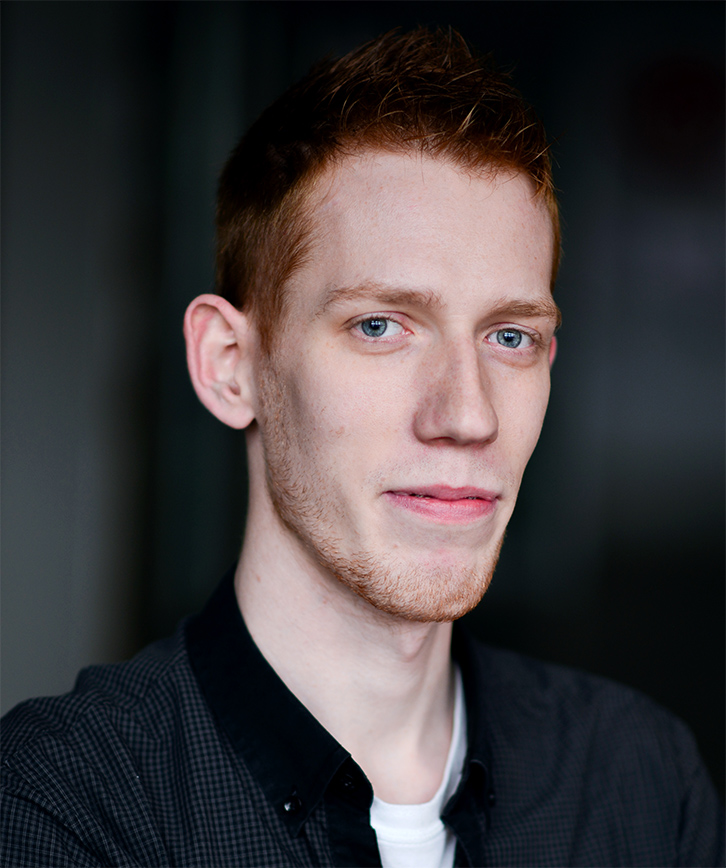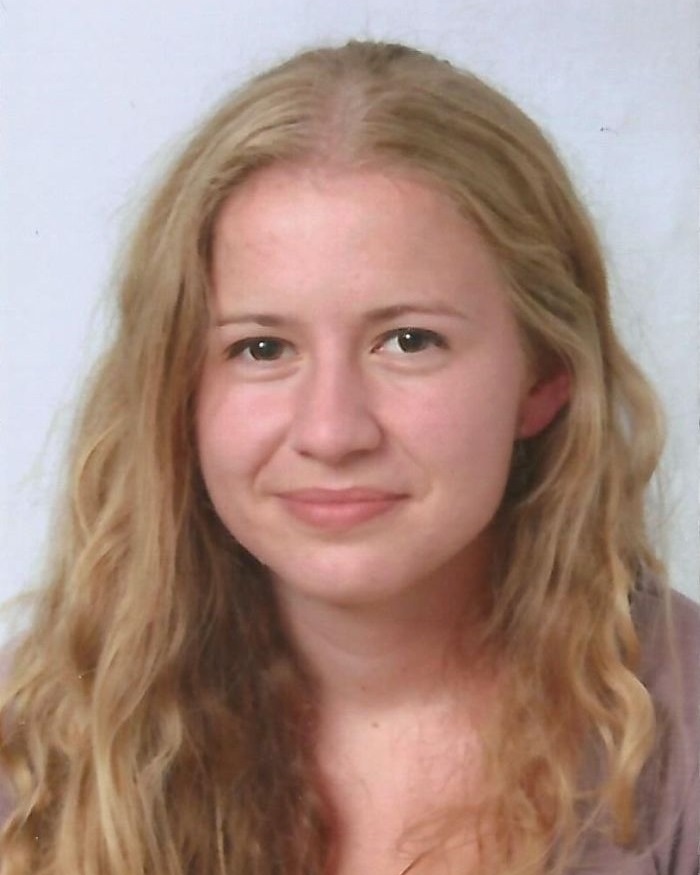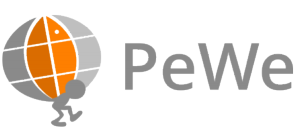- Veronika Balážová: Prediction of users’ personality traits during task solving in information system
- Adam Bacho: Usability of information visualizations in the process of knowledge discovery
- Matej Červenka: Analysis of eye movement patterns depending on task in the web environment
- Mária Dragúňová: Identifying User Characteristics by Eye Tracking Analysis
- Peter Dubec: Effective user studies for mobile devices enhanced with eye tracking
- Patrik Hlaváč: Impact of Characteristics of Individuals on Evaluating the Quantitative Studies
- Tomáš Juhaniak: Cognitive Load Evaluation as a Part of User Studies
- Ondrej Kaščák: User Experience and Emotions
- Aleš Mäsiar: Human-based Computation with the Use of Gaze Tracking
- Michal Melúch: Gaze Visualization
- Martin Mokrý: Identification of the user expertise based on patterns in eyetracking data
- Lukáš Rešutík: Identifying cognitive load
- Monika Sanyová: HCI literacy estimation using eye tracking
- Martin Svrček: Revealing information on social adaptive web
- Elena Štefancová: User Experience and Emotions
- Martin Štrbák: Analysis of Reading Difficulty in Web Environment
Prediction of users’ personality traits during task solving in information system
 Veronika Balážová
Veronika Balážová
master study, supervised by Róbert Móro
Abstract. These days people are using web pages and web applications more often than they had used to. They find here most of the information they are looking for. How user interacts with web page does not only depend on interface or on usability of page, but it depend on user’s characteristics (for example it depends on his personality). On the other hand, interaction with web page can be influenced by emotion of the user.
In our work we plan to analyze impact of the type of the user personality, on his way of dealing with typical tasks in specific domain, for example in online shops. Our goal is to predict user personality based on his interaction with the information system. Also, we plan to predict user emotions or use these emotions for prediction of his personality.
Usability of information visualizations in the process of knowledge discovery
 Adam Bacho
Adam Bacho
master study, supervised by Róbert Móro
Abstract. Nowadays, when more and more people are concerned with data analysis, it is increasingly important to process this data and to obtain great volumes of relevant information from them. But there is a huge amount of such information, and it could be difficult to offer them to users appropriately. One of the options often used in the process of knowledge discovery is to use decision trees. More and more people are starting to discover this particular method, thanks to its easy interpretation. However some ways of visualizing of decision trees may be inadequate and the users get no benefits from them. In our work therefore we focus on the detection of problematic parts while working primarily with decision trees using eye-tracker. Authors in several works have shown that when working with visualizations it is important to consider cognitive abilities of users, therefore we will use so called OSPAN test for working memory in our experiment.
Analysis of eye movement patterns depending on task in the web environment
 Matej Červenka master study, supervised by Jozef Tvarožek
Matej Červenka master study, supervised by Jozef Tvarožek
Abstract. Users perform various types of tasks on the web every day. Tasks includes searching via search engine, shopping, reading, chatting etc.. It is able to increase efficiency of these processes by recording and evaluating interactions of mouse or keyboard. Except of these devices it also able to use eye tracking technology which allow us to better understanding how users are thinking while performing their tasks. Users are thinking different while performing various types of tasks, which reflect in different gaze plots patterns.
In our research we will try to find and automatically identify patterns in gaze plots which are specific to some type of task in web environment. On the basis of these patters we want to predict what kind of task user was doing.
Identifying User Characteristics by Eye Tracking Analysis
 Mária Dragúňová
Mária Dragúňová
master study, supervised by Jozef Tvarožek
Abstract. Human individuailty is composed of many aspects such as knowledge or cognitive abilities. These aspects have impact on every day life and activies. Using computer applications is not an exception. Eye tracking analysis is a good way of identifying and evaluating some of users’ characteristics and knowing the user is a neccessity if we would like to take into consideration his individuality when we create applications or evaluate usability of a user interface.
We propose to identify individual characteritics of user using appropriate eye tracking measures. We would like to create such a program, which can automatically detect distinctive user characteristics.
Effective user studies for mobile devices enhanced with eye tracking
 Peter Dubec
Peter Dubec
master study, supervised by Mária Bieliková
Abstract. Usability is a quality attribute that assesses how easy user interfaces are to use. Nowadays usability testing of mobile applications with use of eye-tracking is realized as traditional usability testing. Therefore it requires specialized laboratory and test moderator. Also it is not possible to easily perform mobile usability testing on multiple participants simultaneously, therefore in most cases these tests are qualitative and not quantitative because we are able to collect only small amount of data.
Our main goal is to make bulk testing of mobile applications possible. We are proposing method to achieve our goal by means of simulating mobile applications on PC and collecting data from PC. At current state testing of mobile applications is performed only with one tester at the time. Our methodology suggests using of UX infrastructure available at our faculty, to make testing with 20 participants simultaneously possible.
It is clear that there are some specific usability problems that can be identified only during testing on real mobile device, but we have discovered and confirmed that we are able to detect multiple usability problems also during emulation on PC.
Impact of Characteristics of Individuals on Evaluating the Quantitative Studies
 Patrik Hlaváč
Patrik Hlaváč
doctoral study, supervised by Mária Bieliková
Abstract. Usability studies in the web domain are based on various metrics, but the question is how to apply these metrics to evaluate a larger group of people. When we consider that every user has different qualities, skills and experiences, we could expect that the results of testing of same scenarios will be different. We focus our research to show that quantitative studies can provide more accurate results if we work with information about personal characteristics of participants.
Cognitive Load Evaluation as a Part of User Studies
 Tomáš Juhaniak
Tomáš Juhaniak
master study, supervised by Mária Bieliková
Abstract. In 2016 we successfully developed non intrusive method for cognitive load measures with using of eyetracker. In our work we develop framework for UX testing based on all possible methods in eyetracking field. Firstly, we have to prove applicability of all methods by the help of lot of recorded eyetracking data in UX sessions. Later on we can offer researchers which method is optimal for their concrete studies, how strong accuracy they can expect from it and we offer software tool to manage all process of UX testing starting with session prepare, ending in data evaluation.
User Experience and Emotions
 Ondrej Kaščák
Ondrej Kaščák
bachelor study, supervised by Ing. Róbert Móro
Abstract. User experience (UX) along with usability are crucial parts of every software product. In order to achieve the best possible usability and user experience, it is necessary to perform testing with real users who can provide us feedback. During testing we collect a lot of data, mostly various kinds of questionnaires, notes and video recorded during session.
In addition, we want to use electroencephalograph (EEG), which measures the cerebral activity of a person or another sensor like GSR, which measures skin conductance response. The goal is to measure physiological changes of a person evoked by emotions that user experiences during testing. Main aim of our work is to propose a method of emotion recognition and to verify possibility of using mentioned devices and collected physiological data during usability testing.
Data collected during test sessions will be further processed, analyzed and we will use machine learning to predict emotions whether they are positive, negative or rather neutral. We do not have to limit our prediction of emotions during whole test session but we can divide collected data into smaller samples according to defined time stamps and then predict emotions in these smaller parts. Emotions predicted in particular time intervals can provide valuable information onpossible problems in specific parts of application.
Human-based Computation with the Use of Gaze Tracking
 Aleš Mäsiar
Aleš Mäsiar
master study, supervised by Jakub Šimko
Abstract. Effective processing of large amounts of information is considered to be one of the problems of current information systems. To some extent, it is possible to automate the process, but often the acquired knowledge is not sufficient for required needs. In those cases, it is common to use a human-provided input, which helps to extend the existing set of knowledge. One of the ways is to use experts to provide information, which is generally of high quality and also is considered to be correct, however, the amount of acquired information is vastly limited. Commonly used alternative is knowledge acquired from large crowds of people, that provide large amounts of data, but without the guarantee of its correctness. This approach can be considered as human computation.
Many human computation approaches struggle with the problem of correctness validation when processing individual answers. Several methods exist, that deal with this problem, but lot of them cannot be applied until there is sufficient amount of answers for the evaluated task.
This work focuses on creating a method, that deals with the problem of correctness evaluation of individual’s answers in a human computation task and for that it uses information acquired from gaze tracking device. This work also addresses application of the designed method on specific tasks and its integration to the task providing system for the purpose of more effective use of crowds’ work.
Gaze Visualization
 Michal Melúch
Michal Melúch
bachelor study, supervised by Ing. Róbert Móro
Abstract. Interest has flourished in studying both the spatial and temporal aspects of eye movement behavior. This has sparked the development of a large number of new methods to compare scanpaths in user experience (UX) research. Usually, each of these analysis methods was developed in order to solve a specific problem. However, each approach quantifies different aspects of scanpath behavior and requires different data-processing techniques. Some methods require that the two scanpaths to be compared have the same lengths, hence the length of the longer scanpath is truncated to the length of the shorter scanpath. Some measures preserve and use the temporal order of fixations; others do not. Finally, the measures differ with respect to the major characteristic they capture. This is why I’ve decided to construct a scanpath analysis/comparison tool usable by any user on system-provided or user-specific data. Primary goal of the bachelor’s thesis is to provide an easy way to compare existing scanpath comparison techniques in real time.
Identification of the user expertise based on patterns in eyetracking data
 Martin Mokrý
Martin Mokrý
master study, supervised by Róbert Móro
Abstract. Identification of repeating patterns from eye tracking data (patterns like sequences of fixations, saccades or areas of interest) is considered to be an important step in eye tracking analysis. Its main focuses are: explanation of recorded interaction, comparison of ways, in which different users interact or clustering of user based on their similarity. This can be used in evaluation of recorded interaction (UX testing) or customization of graphical interface based on identified situation (pattern). This situation e.g. systematic scanning of web page can imply unfamiliarity of user with specific web page. On the other hand, reoccurrences of a similar situation can imply activities of skilled user.
In our work we focus on automatic identification of patterns in scanpaths in eye tracking data, related to domain skill level of user. First phase consists of identifying proper features of fixations and saccades (features not task-related and with high frequency of occurrences) and analysis of methods for creating commons scanpaths and quantification of similarities between scanpaths. Goal of second phase is to implement machine learning model capable of automatic identification of domain skill level of user using just first few seconds of interaction.
Identifying cognitive load
 Lukáš Rešutík
Lukáš Rešutík
bachelor study, supervised by Mária Bieliková
Abstract. New applications are created almost every day. If you want to work with these applications, it is good to know the user’s status by using them. For it has a great influence cognitive load.
In my bachelor thesis i am going to analyse methods of identification of cognitive load. One of the possible ways to identify cognitive load is carried out psychological test with a dual task. I will focus on the analysis of the types of secondary task, and then I will create an application that will be able to measure cognitive load, and verify it with other existing methods such as dilation of pupil.
HCI literacy estimation using eye tracking
 Monika Sanyová
Monika Sanyová
master study, supervised by Eduard Kuric
Abstract. Nowadays testing quality of graphical user interface is very common. For interface quality testing it is good to know about testers as much as possible. One of the
most interesting information about tester is level of his HCI literacy estimated due
to interaction with user interface. Main goal of our work is to construct a method which can automatically estimate user’s HCI literacy focusing on his interaction with interface components. Other goal is to identify relevant eye-tracking (and other) metrics and construct classification method for HCI literacy estimation.
User Experience and Emotions
 Elena Štefancová
Elena Štefancová
bachelor study, supervised by Robert Móro
Abstract. User Experience is one of the most important criterions for designing of the user interfaces and testing of their usability. This includes as its essential element also emotions – how a user feels during interaction with application. Our aim is to measure value of them and research how they are influeced by noticeable mistakes of usability.
For data collection of the basic emotions we want to use electroencephalography (EEG) and facial recognition. EEG is a noninvasive electrophysiological monitoring method, which can with usage of electrodes, placed along the scalp, record electrical activity of the brain. For facial recognition is applied available software with use of a camera. With good approach both of them can help to recognize the current emotional state of the user and how it changes regarding of the usability level.
Revealing information on social adaptive web
 Martin Svrček
Martin Svrček
doctoral study, supervised by Mária Bieliková
Abstract. User Experience (UX) as our research orientation has application in variety of areas as recommendation, education, online shopping etc. Our goal is use approaches of UX to solve the problems of users on the web. In the context of usability we want to use eye-tracking as a tool that can help us to better understand what users doing, where they looking, how they behave or how they fulfill their personal goals on different web-pages and applications. Eye-tracking is relatively new approach in many areas and thus provides us with a lot of interesting views on different problems.
In this context, we also want to use other methods and for example look at the context of user in specific moment which can be related to the user personal state, mood or his/her emotions. In the same way we have an opportunity to use different psychology approaches for better detection of emotions or user personal state. Enhancement of classic sense of the context with the data from eye-tracking enriched with psychology approaches can bring the new way for looking at the user in different domains.
Analysis of Reading Difficulty in Web Environment
 Martin Štrbák
Martin Štrbák
master study, supervised by Marián Šimko
Abstract. Success of Web applications depends on their ability to recognize user characteristics (interests, knowledge, type of personality etc.) and apply them to improve offered services. Mostly, these characteristics are acquired trough analysis of interaction of user with concrete Web application (where is clicking or looking, what is writing). More difficult is to determine if textual web content is interesting. One method to identify if reader is satisfied with content of document is to ask him. This approach has its limitations, because people are not always very honest, or have their own perception of classifying things as boring or entertaining. Questionnaire is a bit more objective. Most used technology nowadays is eye-tracker, which monitors human gaze during process of reading. Another methodology might be to analyze brain waves of user with electroencephalograph (EEG) while reading and compare them when his neural activity is idle. We will use this to determine whether text is difficult or easy to understand for human reader.
